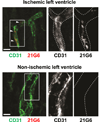Natural IgM Blockade Limits Infarct Expansion and Left Ventricular Dysfunction in a Swine Myocardial Infarct Model
- PMID: 26671971
- PMCID: PMC4687758
- DOI: 10.1161/CIRCINTERVENTIONS.115.002547
Natural IgM Blockade Limits Infarct Expansion and Left Ventricular Dysfunction in a Swine Myocardial Infarct Model
Abstract
Background: Acute coronary syndrome is the leading cause of mortality worldwide. However, treatment of acute coronary occlusion inevitably results in ischemia-reperfusion injury. Circulating natural IgM has been shown to play a significant role in mouse models of ischemia-reperfusion injury. A highly conserved self-antigen, nonmuscle myosin heavy chain II, has been identified as a target of pathogenic IgM. We hypothesized that a monoclonal antibody (m21G6) directed against nonmuscle myosin heavy chain II may inhibit IgM binding and reduce injury in a preclinical model of myocardial infarction. Thus, our objective was to evaluate the efficacy of intravenous m21G6 treatment in limiting infarct expansion, troponin release, and left ventricular dysfunction in a swine myocardial infarction model.
Methods and results: Massachusetts General Hospital miniature swine underwent occlusion of the midleft anterior descending coronary artery for 60 minutes, followed by 1 hour, 5-day, or 21-day reperfusion. Specificity and localization of m21G6 to injured myocardium were confirmed using fluorescently labeled m21G6. Treatment with m21G6 before reperfusion resulted in a 49% reduction in infarct size (P<0.005) and a 61% reduction in troponin-T levels (P<0.05) in comparison with saline controls at 5-day reperfusion. Furthermore, m21G6-treated animals recovered 85.4% of their baseline left ventricular function as measured by 2-dimensional transthoracic echocardiography in contrast to 67.1% in controls at 21-day reperfusion (P<0.05).
Conclusions: Treatment with m21G6 significantly reduced infarct size and troponin-T release, and led to marked preservation of cardiac function in our study. Overall, these findings suggest that pathogenic IgM blockade represents a valid therapeutic strategy in mitigating myocardial ischemia-reperfusion injury.
Keywords: immunology; inflammation; left ventricular function; myocardial infarction; troponin T.
© 2015 American Heart Association, Inc.
Figures




References
-
- Suero JA, Marso SP, Jones PG, Laster SB, Huber KC, Giorgi LV, Johnson WL, Rutherford BD. Procedural outcomes and long-term survival among patients undergoing percutaneous coronary intervention of a chronic total occlusion in native coronary arteries: A 20-year experience. J Am Coll Cardiol. 2001;38:409–414. - PubMed
-
- Daneault B, Genereux P, Kirtane AJ, Witzenbichler B, Guagliumi G, Paradis JM, Fahy MP, Mehran R, Stone GW. Comparison of three-year outcomes after primary percutaneous coronary intervention in patients with left ventricular ejection fraction <40% versus >/= 40% (from the HORIZONS-AMI trial) Am J Cardiol. 2013;111:12–20. - PubMed
-
- Kelly DJ, Gershlick T, Witzenbichler B, Guagliumi G, Fahy M, Dangas G, Mehran R, Stone GW. Incidence and predictors of heart failure following percutaneous coronary intervention in ST-segment elevation myocardial infarction: The HORIZONS-AMI trial. Am Heart J. 2011;162:663–670. - PubMed
-
- Piot C, Croisille P, Staat P, Thibault H, Rioufol G, Mewton N, Elbelghiti R, Cung TT, Bonnefoy E, Angoulvant D, Macia C, Raczka F, Sportouch C, Gahide G, Finet G, Andre-Fouet X, Revel D, Kirkorian G, Monassier JP, Derumeaux G, Ovize M. Effect of cyclosporine on reperfusion injury in acute myocardial infarction. N Engl J Med. 2008;359:473–481. - PubMed
Publication types
MeSH terms
Substances
Grants and funding
LinkOut - more resources
Full Text Sources
Other Literature Sources
Medical

